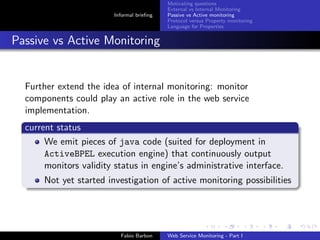Service Composition Monitoring
- 1. Informal brie’¼üng Web Service Monitoring - Part I An Introduction (informal) Fabio Barbon Astro project ITC-IRST 21.09.2005 Fabio Barbon Web Service Monitoring - Part I
- 2. Motivating questions External vs Internal Monitoring Informal brie’¼üng Passive vs Active monitoring Protocol versus Property monitoring Language for Properties Motivating questions External versus Internal monitoring Passive versus Active monitoring Protocol versus Property monitoring Language for Properties Fabio Barbon Web Service Monitoring - Part I
- 3. Motivating questions External vs Internal Monitoring Informal brie’¼üng Passive vs Active monitoring Protocol versus Property monitoring Language for Properties External Monitoring We1 donŌĆÖt trust completely our partners2 Observational behaviour We sense communication I/O From identity relation on states to distinguishability equivalence relation on states current status We automatically synthesize protocol and KPLTL property monitors via a power-set construction over an STS set representing a web service choreograpy. 1 as service composers and/or composed service providers 2 component service providers Fabio Barbon Web Service Monitoring - Part I
- 4. Motivating questions External vs Internal Monitoring Informal brie’¼üng Passive vs Active monitoring Protocol versus Property monitoring Language for Properties Internal Monitoring We donŌĆÖt trust completely ourselves Actual (activity-level) behaviour Observational reasoning still possible (via localhost monitoring) Full Knowledge (we are inside execution engine) We can mix observational and actual behaviour information. current status Just started investigation of internal monitoring possibilities and technical issues. Fabio Barbon Web Service Monitoring - Part I
- 5. Motivating questions External vs Internal Monitoring Informal brie’¼üng Passive vs Active monitoring Protocol versus Property monitoring Language for Properties Passive vs Active Monitoring Further extend the idea of internal monitoring: monitor components could play an active role in the web service implementation. current status We emit pieces of java code (suited for deployment in ActiveBPEL execution engine) that continuously output monitors validity status in engineŌĆÖs administrative interface. Not yet started investigation of active monitoring possibilities Fabio Barbon Web Service Monitoring - Part I
- 6. Motivating questions External vs Internal Monitoring Informal brie’¼üng Passive vs Active monitoring Protocol versus Property monitoring Language for Properties Protocol Monitoring A protocol monitor veri’¼ües that a service behaves consistently with its published interaction ’¼éow (protocol) Automatically generated using only Abstract BPEL speci’¼ücation (no need to mark-up anything) Is generated as a deterministic STS with a set of ’¼ünal states It monitors: Message lexicon Correct life (message order preserved (by parallel exec)) Correct death (serviceŌĆÖs instance wonŌĆÖt die prematurely) current status done. (complexity bounds for protocol monitor?) Fabio Barbon Web Service Monitoring - Part I
- 7. Motivating questions External vs Internal Monitoring Informal brie’¼üng Passive vs Active monitoring Protocol versus Property monitoring Language for Properties KPLTL Property Monitoring Knowledge-level Past-only LTL K(User.state=CANC) -> (O K(Hotel.state=CANC) & O K(Flight.state=CANC)) Automatically generated using Abstract BPEL speci’¼ücations and a formula like the one above No restriction to single services: formulas can traverse (asyncronous) choreographies Shifting to belief-level needs a (reasonable) interpretation for equality between states: know and maybe? current status done (past-time only, know/maybe modes!). Fabio Barbon Web Service Monitoring - Part I
- 8. Motivating questions External vs Internal Monitoring Informal brie’¼üng Passive vs Active monitoring Protocol versus Property monitoring Language for Properties Language for Choreography Properties State-based or Message-based? Need to speak about future? LTL, regular expressions, ...? Knowledge-level monitoring? current status Just started investigation Strong need for realistic scenarios of property monitoring. Fabio Barbon Web Service Monitoring - Part I







